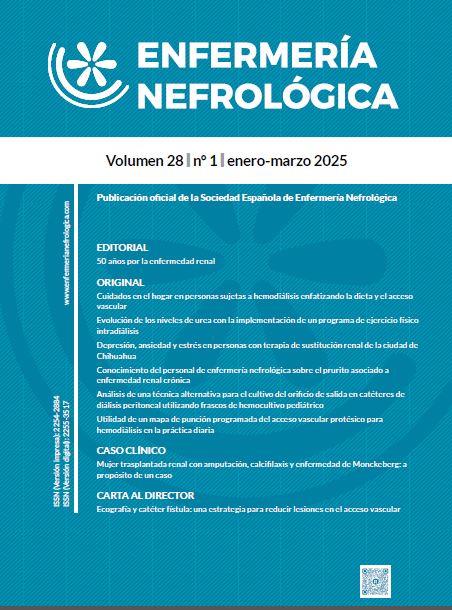Contenido del artículo principal
Resumen
Introducción: Los riñones de pacientes con enfermedad renal crónica no pueden filtrar y eliminar adecuadamente la urea. Niveles altos de esta molécula son perjudiciales para su salud. Existe evidencia de que el ejercicio ayuda a eliminar la urea durante la hemodiálisis.
Objetivo: Describir la evolución de los niveles de urea en el tiempo al realizar un programa de ejercicio físico aeróbico de baja intensidad en pacientes en hemodiálisis.
Material y Método: Estudio cuasi experimental longitudinal con 10 pacientes, en quienes se aplicó un programa de ejercicio aeróbico durante 14 semanas. Se registraron los niveles de urea antes y después de la hemodiálisis con análisis de nitrógeno ureico en sangre.
Resultados: Se observó una disminución en los niveles de urea de 107,58 a 79,34 mg/dL (hombres) y de 82,09 a 56,40 mg/dL (mujeres) en los análisis de nitrógeno ureico en sangre pre ejercicio entre las semanas 0 y 14 del programa de ejercicio (p=0,022).
Conclusiones: Realizar un programa de ejercicio físico aeróbico durante la sesión de hemodiálisis se relaciona con una disminución de los niveles de urea pre y post hemodiálisis a lo largo del tiempo. Por tanto, la implementación de ejercicio físico aeróbico podría estar relacionado con un aumento en la depuración de urea en pacientes con enfermedad renal crónica.
Palabras clave
Detalles del artículo
Derechos de autor 2025 Alejandro Aguiar Chávez, Isidora Gallardo García, Binniza Martínez López

Esta obra está bajo una licencia internacional Creative Commons Atribución-NoComercial 4.0.
Aviso de derechos de autor/a
© Los autores ceden de forma no exclusiva los derechos de explotación de los trabajos publicados y consiente en que su uso y distribución se realice con la Licencia Creative Commons Atribución - No comercial 4.0 Internacional (CC BY-NC 4.0). Puede consultar desde aquí la versión informativa y el texto legal de la licencia. Esta circunstancia ha de hacerse constar expresamente de esta forma cuando sea necesario.
Referencias
- Lorenzo V, Luis D. Enfermedad Renal Crónica. Nefrología al día [Internet]. 2023 [consultado 11 Nov 2024]; Disponible en: https://www.nefrologiaaldia.org/es-articulo-enfermedad-renal-cronica-136
- Argaiz ER, Morales-Juárez L, Razo C, Ong L, Rafferty Q, Rincón-Pedrero R, et al. La carga de enfermedad renal crónica en México. Análisis de datos basado en el estudio Global Burden of Disease 2021. GMM [Internet]. 2023 [consultado 11 Nov 2024]; 159(6):12575. Disponible en: https://www.scielo.org.mx/pdf/gmm/v159n6/2696-1288-gmm-159-6-501.pdf DOI: https://doi.org/10.24875/GMM.23000393
- García G, Chavez J. The Tragedy of Having ESRD in Mexico. Kidney International Reports. 2018;3(5):1027–9. DOI: https://doi.org/10.1016/j.ekir.2018.07.018
- Cruz Llanos LE, Cieza Zevallos JA. Relación entre el índice urémico y la función renal en pacientes con enfermedad renal crónica y en personas sanas. Rev Med Hered. 2022;32(4):216–23. DOI: https://doi.org/10.20453/rmh.v32i4.4118
- Fundación Mayo para la Educación y la Investigación Médicas. Análisis de nitrógeno ureico en sangre [Internet]. 2024 [consultado 13 Nov 2024]; Disponible en: https://www.mayoclinic.org/es/tests-procedures/blood-urea-nitrogen/about/pac-20384821
- Mas S, Gracia Iguacel C, González-Parra E. Toxinas Urémicas. Nefrología al día [Internet]. 2023 [consultado 11 Nov 2024]; Disponible en: https://www.nefrologiaaldia.org/es-articulo-toxinas-uremicas-603
- American Kidney Fund. Prueba de nitrógeno ureico en sangre (BUN) [Internet]. 2023 [consultado 8 Nov 2024]; Disponible en: https://www.kidneyfund.org/es/todo-sobre-los-rinones/las-pruebas-de-deteccion-de-la-enfermedad-renal/prueba-de-nitrogeno-ureico-en-sangre-bun
- Fernández M, Ibarra J, Aguas E, González C, Quidequeo D. Revisión: Beneficios del ejercicio físico en pacientes con enfermedad renal crónica en hemodiálisis. Enferm Nefrol. 2018;21(2):167–81. DOI: https://doi.org/10.4321/S2254-28842018000200008
- Alonso M, Midley A, Crucelegui M, Patiño O, Galarza M, Phillipi R, et al. Evaluación de un programa de actividad física intradialítica en pacientes con hemodiálisis. Nefrología Latinoamericana. 2017;14(1):4–11. DOI: https://doi.org/10.1016/j.nefrol.2016.11.002
- Brown PDS, Rowed K, Shearer J, MacRae JM, Parker K. Impact of intradialytic exercise intensity on urea clearance in hemodialysis patients. Appl Physiol Nutr Metab. 2018;43(1):101–4. DOI: https://doi.org/10.1139/apnm-2017-0460
- Paluchamy T, Vaidyanathan R. Effectiveness of intradialytic exercise on dialysis adequacy, physiological parameters, biochemical markers and quality of life - A pilot study. Saudi Journal of Kidney Diseases and Transplantation. 2018;29(4):902–10. DOI: https://doi.org/10.4103/1319-2442.239661
Referencias
Lorenzo V, Luis D. Enfermedad Renal Crónica. Nefrología al día [Internet]. 2023 [consultado 11 Nov 2024]; Disponible en: https://www.nefrologiaaldia.org/es-articulo-enfermedad-renal-cronica-136
Argaiz ER, Morales-Juárez L, Razo C, Ong L, Rafferty Q, Rincón-Pedrero R, et al. La carga de enfermedad renal crónica en México. Análisis de datos basado en el estudio Global Burden of Disease 2021. GMM [Internet]. 2023 [consultado 11 Nov 2024]; 159(6):12575. Disponible en: https://www.scielo.org.mx/pdf/gmm/v159n6/2696-1288-gmm-159-6-501.pdf DOI: https://doi.org/10.24875/GMM.23000393
García G, Chavez J. The Tragedy of Having ESRD in Mexico. Kidney International Reports. 2018;3(5):1027–9. DOI: https://doi.org/10.1016/j.ekir.2018.07.018
Cruz Llanos LE, Cieza Zevallos JA. Relación entre el índice urémico y la función renal en pacientes con enfermedad renal crónica y en personas sanas. Rev Med Hered. 2022;32(4):216–23. DOI: https://doi.org/10.20453/rmh.v32i4.4118
Fundación Mayo para la Educación y la Investigación Médicas. Análisis de nitrógeno ureico en sangre [Internet]. 2024 [consultado 13 Nov 2024]; Disponible en: https://www.mayoclinic.org/es/tests-procedures/blood-urea-nitrogen/about/pac-20384821
Mas S, Gracia Iguacel C, González-Parra E. Toxinas Urémicas. Nefrología al día [Internet]. 2023 [consultado 11 Nov 2024]; Disponible en: https://www.nefrologiaaldia.org/es-articulo-toxinas-uremicas-603
American Kidney Fund. Prueba de nitrógeno ureico en sangre (BUN) [Internet]. 2023 [consultado 8 Nov 2024]; Disponible en: https://www.kidneyfund.org/es/todo-sobre-los-rinones/las-pruebas-de-deteccion-de-la-enfermedad-renal/prueba-de-nitrogeno-ureico-en-sangre-bun
Fernández M, Ibarra J, Aguas E, González C, Quidequeo D. Revisión: Beneficios del ejercicio físico en pacientes con enfermedad renal crónica en hemodiálisis. Enferm Nefrol. 2018;21(2):167–81. DOI: https://doi.org/10.4321/S2254-28842018000200008
Alonso M, Midley A, Crucelegui M, Patiño O, Galarza M, Phillipi R, et al. Evaluación de un programa de actividad física intradialítica en pacientes con hemodiálisis. Nefrología Latinoamericana. 2017;14(1):4–11. DOI: https://doi.org/10.1016/j.nefrol.2016.11.002
Brown PDS, Rowed K, Shearer J, MacRae JM, Parker K. Impact of intradialytic exercise intensity on urea clearance in hemodialysis patients. Appl Physiol Nutr Metab. 2018;43(1):101–4. DOI: https://doi.org/10.1139/apnm-2017-0460
Paluchamy T, Vaidyanathan R. Effectiveness of intradialytic exercise on dialysis adequacy, physiological parameters, biochemical markers and quality of life - A pilot study. Saudi Journal of Kidney Diseases and Transplantation. 2018;29(4):902–10. DOI: https://doi.org/10.4103/1319-2442.239661




